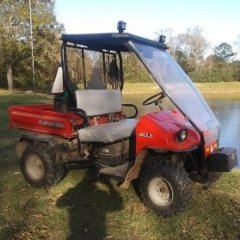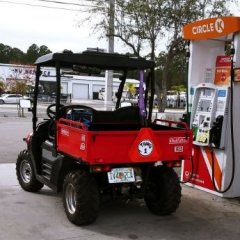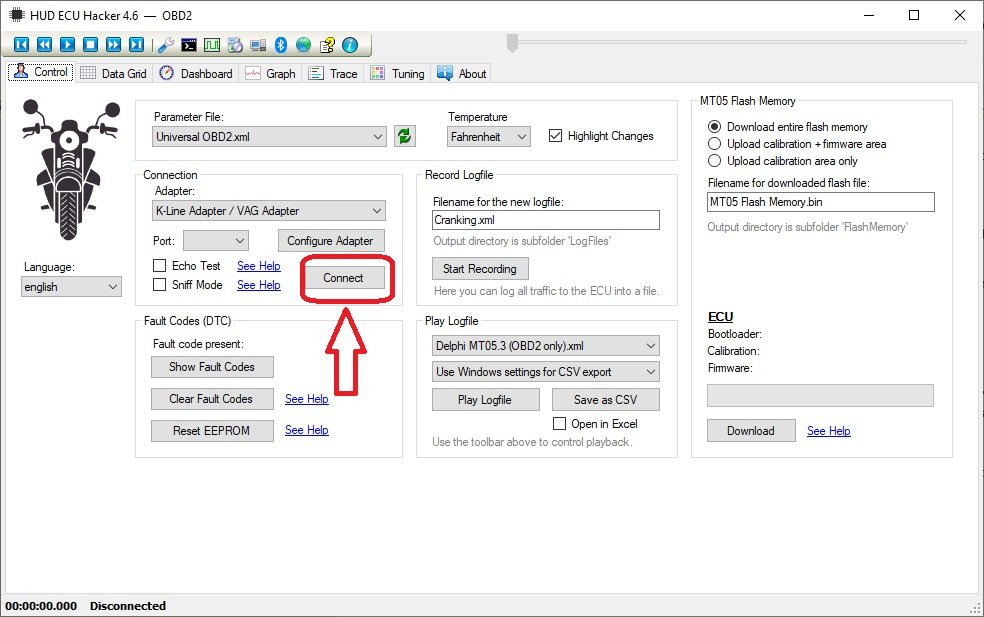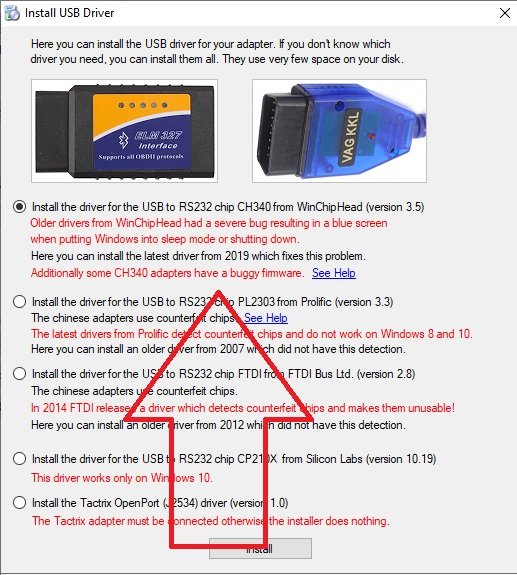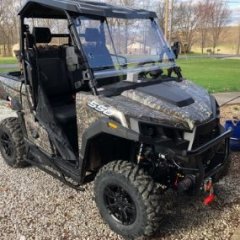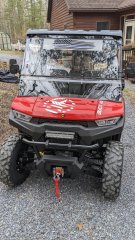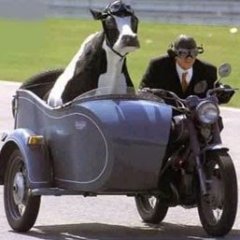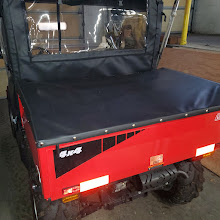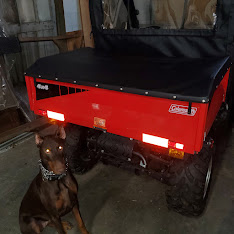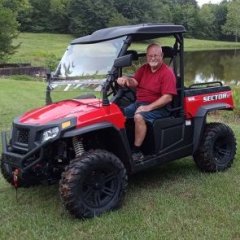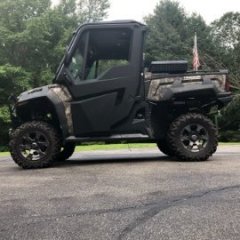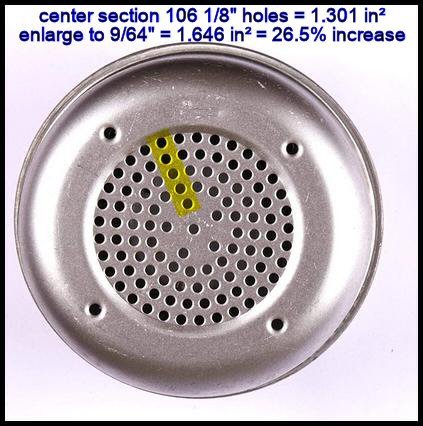Leaderboard
Popular Content
Showing content with the highest reputation since 01/25/2021 in Posts
-
Since I've seen some questions on this I took some pictures and will provide instructions on a valve adjustment for the UT400. This should be the same for the 550's and other various Coleman/Hisun single cylinder models with the cylinder slanted aft. I have seen several people ask of it is really necessary, and read several reports of valves being out of adjustment from the factory. My valves were .004" intake, and .010" exhaust with about 5 hrs on the machine. I've seen different numbers thrown around for factory spec, but I decided to go with 0.005". This is called valve lash. What is is is a gap between the rocker arm and the valve then the camshaft isnt opening the valve. Why does it matter? If it's too large the valve doesn't open all the way, if it's too small the valve dosent close. This can cause valve damage (overheating) as well as loss of engine power (burned fuel is going out exhaust rather than pushing the piston dow). Tools required : 5MM Allen wrench, 10MM box wrench, needle nose pliers, flat feeler gauge set, rags First you need to remove the fan cover on the passenger side. There is a cooling vent hose on the back side, remove the hose clamp and slide it off. From there there are 4x 10mm bolts holding the cover. The forward ones can be accessed from under the seat. Next remove the spark plug from the drivers side. Carefully wiggle the spark plug wire off. Grip it as low as possible and give it a little twisting motion as you pull it off to help free it. Its a tight fit for a socket, but there is a sheet metal wrench in the toolkit that fits it. Unscrew the plug and set it aside. This allows you to spin the motor over freely with no compression to fight. When you reassemble this is a good opportunity to switch to an NGK iridium plug for better performance/less fouling DR8EIX) Next you need to remove the intake and exhaust valve covers. The intake us the forward one. There are 3x 5MM Allen screws to remove. The Exhaust is the rear with 2x 5MM Allen bolts. Both covers have O-Rings instead of gaskets and are reusable. When you remove the rear be careful and use your rags as there will be oil that drips out. Next up we need to spin the motor over to top dead center. Grab each rocker arm and give em a little wiggle up and down. Spin the engine over by grabbing the fan with your other hand. Spin the engine over until both rockers have some wiggle and are loose. Once both rockers are loose slide the feeler gauge in like shown above. Try different feelers as needed to determine your starting spec. You should feel some drag but still be able to move the feeler without too much force. If you need to adjust, use the 10MM wrench to slightly loosen the locknut, then with the correct feeler gauge in place, tighten the top square nut while wiggling the feeler in and out. Once you have it right you need to tighten the 10mm lock nut without moving the square head bolt. Once the lock nut is tight recheck the clearance. That's it, button everything back up and make sure you have it all reassembled before running it again. If you find this helpful give me a thumbs up or comment. If you have any questions or need more help let me know. If there's interest maybe I'll do some more of these6 points
-
In order to connect with the ECU we need two cables. The first is a USB ODBII cable. HUD ECU Hacker’s documentation has a lot of different confusing options, but here’s what I went with and managed to get working, the cable is called “VAG KKL” it is a USB to ODB2 cable. It is available from a variety of sources for $10-15. The second thing we need is a “6 pin delphi to ODB2” adapter cable. It is also available for a similar price. In my case I ordered both from ebay, but there are other sources. Once we have our cable in hand we need to find the plug it in on your machine. My personal rig is a Coleman UT400, but the wire location should be similar for all Hisuns. My cable was located under the middle of the seat area. Just inboard of the battery, where the main wire harness split loom runs. The cable is a 6 pin (3x2) with a dust cap. Remove the dust cap and plug in the 6-pin end of the Delphi adapter cable. Note: When I was done, I left the 6-pin adapter connected, and zip tied it so it now runs to in front of the battery for easier access in the future. Next download and install HUD ECU HACKER DOWNLOAD Open HUD ECU Hacker on your PC It should prompt you to choose a driver to install. This particular cable uses the “CH340” driver (First choice on the menu) click to install, once installed hit the X in the corner to go back to the main page Once the driver is installed plug in the USB Cable, and plug the ODB2 end into the 6 pin adapter. The red led on the adapter should light up indicating it has power. Drop down and pick a com port on the main screen, it should show the VAG KKL adapter as a com port. Click connect on the main menu. It will pop up a bunch of fast scrolling text indicating it is connecting. Once connected you can click through the various tabs to see different data sets. The main menu also has the option to show fault codes, clear fault codes, reset the EPROM back to factory. The other function that may be helpful is recording a log file. You can record a log while operating the unit, and come back later and replay it to try to better diagnose what is happening. Within the various pages you will see the reading from each sensor. Sometimes a sensor reading will be off enough to cause running issues, but not enough for the ECU to realize its an issue. For example if the engine thinks it’s really warm, but its actually cold, it may not inject enough fuel to start. There are also more advanced functions, like adjusting fuel mapping, but that is beyond the scope of this tutorial. Full HUD ECU Hacker Documentation (Very technical reading) If you find this helpful give me a comment below or a thumbs up.5 points
-
White smoke is usually coolant leaking into the cylinder. Sounds like a blown head gasket to me.4 points
-
Just wanted to give update . It was the ecm. Put new one on and got spark immediately to front cylinder. Ran but smoking and no power. I checked back cylinder and no fire. Pulled coil to check with meter and found wire was not getting good connection where it plugs into coil. All good now . She will scream !!!. Next is to figure out why 4x4 switch wont turn. Thanks for all the imput....4 points
-
Hello to anyone who reads this. I am Jon and I own J&M Outdoor Power, a very small, small engine repair shop. I was approached by Coleman about 6 months ago to become one of their Warranty Centers. I recently received 3 different UT400's and a UT500 all with similar issues. These units range from 2 months to 2 years old. Customers state that the unit(s) was/were running fine, then heard a pop and a loss of power, two would no longer start. The two that would run would not achieve normal operating speed (around 20mph I would say) without redlining the RPMs. I quickly found that the Valve lash on each unit had become too large on some(both intake and exhaust) and too tight on one(just intake). After setting the gaps to .005(I found multiple different people suggesting bigger and smaller gaps, but no definitive Coleman Spec number yet) every unit starts, runs, and achieves top speed without issue. I don't know how many others have come across these issues, and I wanted to get something out on the web for others in the same predicament. Please let me know if you have had similar issues. Edit: I realize that this will not be a fix all solution for this issue, as the oil level and condition should be verified before moving to the valves. Many times improper oil conditions will cause valve lash to change. These units all have good oil and proper oil changes.3 points
-
Hello again! I now have a pretty good running Coleman UT400 after a top end rebuild, wet clutch rebuild and a repaired crankcase... ! It plows snow great, but I was also having the jumping out of gear problem, mainly reverse, but a couple times out of forward. I would quickly place it in N and then let the engine idle down and shift again. This worked most of the time. I did some research and found that some have modified the shift linkage. The problem with just adjusting the shift cable is that it really NEEDS more throw, not an adjustment. From what I've read and viewed on the Internet, the linkage arm needs to be about 3/4" longer to gain more throw in both directions. On YouTube, the guy had to remove the shift linkage hole trim and notch the side of the dash to get the shift linkage off the pivot pin. BUT this is NOT necessary. When the "E" clip has been removed and you fish it out of the firewall somewhere, the shift lever is now loose. I had to pop the top of the shift knob off, remove the retaining screw and then heat the lower portion of the knob to get it to come off the lever. Once you have the shift lever loose, push it towards the right to slide it off the pivot shaft. But it won't come off just yet. Use a small pry bar/screw driver and slide the nylon flanged bushing out of the left side of the lever. This lets the lever slide off and get into a "loose" condition and it will twist and come right off without removing the dash trim, that could be a bugger to get back on correctly. Once the lever is off, press out the other bushing so when you're welding on the linkage arm, you don't melt the bushing. I found a piece of scrap metal the same thickness as the lever arm, just over 1/8" thick, close to 3/16". I cut my arm and beveled the edges for better welding. I added a piece just over 5/8" long and kept about a 1/16" gap between the arm and the new piece. Once welded on bother ends, it adds up to just about 3/4" or so. I reinstalled the lever after painting it and did an adjustment on the cable. By the way, it's easier to remove the cable from the bracket on the frame. This gives you more clearance to maneuver in that area with your hands. ALSO, you will need to get a 12" adjustable wrench and slide it over the cable mounting bracket and tweak, to the front, the steel so the cable is pointed upward a bit to now realign with the new longer shift arm lever. There's more than enough metal for the tweak and it will line up perfectly. I now bottom out the shifter on the transmission BEFORE I run out of throw on the shifter... I've tested it just a bit so far and it shifts much better with the longer throw. One of the Coleman authorized repair facilities said that he worked with Coleman to get a new part that's longer by 3/4". He's modified a few and it works perfectly for him. Just doing the cable will just short you on the other end. Here's some pictures of my modified shift lever etc.3 points
-
I have come to the conclusion @Joe Toup must be one of the very best, most helpful members here!!! He has been tireless sharing his knowledge and expertise helping me solve a problem. I am sure I'm near a good solution thanks to Joe!!👍👍👍3 points
-
There are actually 5 disc brakes on these machines. 1 for each wheel and 1 on the rear driveshaft for the parking brake. I've read several complaints of the parking brake one being too tight from the factory so I would check the cable and make sure there's a little slack when the parking brake is released. If that is good I would jack up each corner Individually and spin the wheel to listen for noise and feel for dragging. That should help pinpoint where the issue is.3 points
-
anybody else getting spam /fraud private messages on here besides me? How do I report it? He calls himself Maria .under ORANGE 15 name.. wants to hook up in UTVs .. con artist in Pakistan probably.. Cant ADMIN block this crap ? geesh3 points
-
Just looked at the Lowes add for that, pretty much looks like an MSU 500/700 that Hisun made for Massimo back then. Take a good look at the badging on parts to see who it's actually made by, my guess is it's still Hisun.3 points
-
Its my 2nd day on this plat form. I'm new here in this community but in these two days I got some Premium recommendations. I was in search of these recommendations form the past few months. Thanks you so much for creating such kind of the community. Regards: Zeeshan Mehmood3 points
-
Put 15 miles on it today mostly on the beach in 4WD--the front diiferential is definitely smoother and quieter, and engaging/disengaging 4WD and front lock more positively with the ATF...3 points
-
3 points
-
The main trick is tilting the front end up. Block the rear wheels and jack up the front end at least a foot. A convenient ditch works well also.....rear wheels in a shallow ditch. The head bleeder screw should be opened. With the engine NOT running, almost fill the radiator (leave some air to avoid a mess) and burp (squeeze the lower hose line before the metal tube at the engine base passenger side floor area). Watch the radiator and the the bleeder. With the radiator "higher" than the head bleeder, the air should be bled and coolant dribble out. Close the bleeder and refill radiator (your clue you displaced the air with coolant) and start the engine. Burp more while running and if you get the circulation going the hoses will warm up. More bubbles should surface at the radiator filler neck. Shut off engine. Open bleeder and release any air in the head. The puke jug needs to be filled about an inch above the full cold line. Use a shop towel as a "seal"and use an air nozzle to SLIGHTLY pressurize the puke tank removing the air from the tubing line to the radiator neck. Then the radiator starts to overflow, a third hand can install the radiator cap. Run the engine and determine the head and hoses are at the close to the same temperature (as in warming up) through out the system. IR temp gun....fairly cheap now....can get real numbers. Scan the radiator, hoses, cylinder and head.....if all close you are done. Recheck fluids when done riding. Recheck the bleeder and top off the puke jug as required.2 points
-
Its' not a car, this is a motorcycle engine with a small stator charging system. You can't expect to run high wattage accessories like a heater or huge light bars on these things . That will overwhelm the charging system, drain your battery an stop your engine. Could damage the charging system and voltage regulator too. You only have about 10 amps extra to run any accessories including lights.2 points
-
My dealer gave me an electronic version of the service manual and I have sent it to Kingfish. I will see if it will upload here for others to use. I'm not sure if there is a more appropriate way to do this, let me know if there is.. 2015-2017 Service Manual - Sector E1.pdf2 points
-
my Hisun in my Massimo , sold by Tractor Supply, assembled in Dallas, say Made In China on every part of all of it .. Altho it now has multiple Yamaha parts mixed in. lol2 points
-
2 points
-
Massimo MSU500 won't shift to low I would check the shift linkage. Adjust it make it a little longer, if it is not long enough it won't shift to low2 points
-
The P.S. has me thinking......you mention "Fuel mist" out of the valve rocker cover. All you should is basically NOTHING at crank speed. Any vapors blown out are from blow by (past the rings) into the crankcase. IF you are OVER FUELING and wetting down the cylinder walls (that is, washing off the oil coating) you will have blow by. Oil coating helps seal the rings. That is why an engine that has set (dried out) and low compression is given a shot of WD-40 or any light oil to seal the rings. This leads to the next thought.....If over fueling, the raw gas will "drain" into the crankcase and dilute the motor oil. Check motor oil level.....too high?....too thin?.....wipe on tissue and sniff the oil....Gassy smell?....will light off with a burn test (soak up some oil on a paper towel and see how fast it starts to burn). Oil basically won't. Diesel will start slowly but take off. Gassy oil....if you value the hair on body parts...hold at a distance with long needle pliers!!!! Gassy diluted motor oil will add to the fuel/air mixture via the breather tube. Similar to a turbo seal failure on a diesel......RUNAWAY even after the injector pump shut down...very bad ending! Drain oil and replace filter....won't get it all (always some oil remains that cannot drain) but will dilute the gas. BONUS: Pulling the vent tube will clean up a mystery RICH run be it carb or FI (everything is correct BUT) after the motor warms up and cooks off the gasoline----sorta like an EGR Evap system. Slop fuel never lights off or barely runs depending on the degree of "slop". You state pulling the injector, the engine runs until it runs out of fuel. ARE you leaving the injector hole OPEN. This will allow lots of fresh air into the cylinder and will light off a rich mixture and then die because no more fuel is injected. ASSUME the ECM is sending the correct pulse width to the injector for now. Injector can hang and "piss" instead of spray. The key is the 14.7/1 air fuel mixture. Too RICH.....runs heavy and then dies at idle. May start to run, but as the leftover UNburned charge gets richer-----labors-----pukes. Too Lean......no start....fuel is there but cannot lite off.....then as it builds up, you get a pop only to be to lean again.....repeats the cycle.....THIS IS HELL ON THE STARTER AND REDUCTION GEARS. This also load the oil with gasoline (unburned). Again the fuel correct, look for a restriction in the air intake (not enough air).....common causes....CRITTERS...mouse house....full of acorns....rag pulled in for a nest, and so on. EASY TEST: Remove the air intake plumbing at the throttle body. Plenty of air now. If runs, check out the air box/plumbing. IF NO RUN....next section. Too much fuel: Time to test the ECM/injector system. ANY BAD input signal to the ECM will make the fuel delivery too much or too little. Pull spark plug. Read the insulator tip color. Just right is a light TAN color. Very WHITE...blistered LEAN. RICH has a BLACK, SOOTY, shiny black/wet black (carbon is fuel soaked). If really black, they might fire outside to the engine block BUT "blowout" under compression even at idle. If not too bad, they might run at idle but when sputter and die when a heavy demand on the ignition system (acceleration) is applied....drop in a new plug for testing to just to reduce the possible list of problems. Pull the connector to the fuel pump (under the pass seat). This is the fuel pump power (from ECM) and fuel level signal. No guessing if you found the right fuse/relay. This will stop the fuel delivery (40 PSI) to injector. Injector will still get pulses. You will shoot a short burst of starter fluid into the air box (plumbing reattached and filter OK). The motor should lite off and run until it is out of fuel. Repeat. Repeat. If works every time, give a double burst when running to "sustain" the run. Repeat. If this works, you have the ECM/input signals to ponder. This gets deep for most. Coolant temp sensor....open circuit RICH. Thinks it is at the SOUTH POLE -40 C. Like a choke for carb. Throttle position sensor.....wrong fuel mix to match the air thru the butterfly valve. MAP sensor/ambient air temp....measures engine load....wrong signal rich and lean. O2 sensor....signal to tell if RICH or LEAN. Has heater circuit to get it up to operating temp. Heaters open (toaster that does not toast). Throw in smashed wires, critters that live the taste of plastic insulation on wires, stick run thru harness, heater shorted to SHARP edged heat shield above the exhaust. More common failures are the MAP/IAT (intake air parameters) and O2 sensor. You got a lot of checks to get down to where the problem is. BTW, the ECM is a DELPHI MT05 small engine unit capable of a twin (2 inputs for the two cylinders individual O2 sensors). Check out web page for specs, pin outs for both the Grey and Black connector (PDF format)....magnitudes better than the "manual" supplied when first built. Only covers the electrical engine management with a generic diagram of the analog input(s) and the outputs like fuel pump, ign coil, etc CHOW.2 points
-
2 points
-
2 points
-
View File Outfitter-UT400-ShiftCable Adjustment I got this from Coleman, detailed instruction re: shift cable adjustment... I forgot to mention you will need two 22 mm wrenches for the cable lock nuts. I hacked up a couple of cheap "quality tools for less" combination wrenches using a cut-off wheel in an angle grinder: Kind of like "flare nut wrenches", good for light duty like this. Submitter cliffyk Submitted 03/19/2021 Category Coleman2 points
-
after all the complaints on this forum about the other brands of utv's, i will stick with my mule...........not the fastest, not the most powerful, but it hauls stuff around the house and plows snow just fine..........2 points
-
https://www.colemanequip.com/parts/details/KubotaParts/Kubota-Front-Accessory-Box/K7311-99560/ You might also see what a local or nearby Kubota dealer can get it for. 99% Of the time they won't charge shipping when it's shipped to a dealer.2 points
-
Causes Low oil. Wrong oil. Using the throttle to hold you on an incline. Instead of using the break. Hauling/towing heavy load in high gear. These are a few I can think of. Best way to test a wet clutch or a CVT belt or something else. Raise the rear of the machine. Remove the cover on CVT housing. Start machine and put in gear. See if the CVT belt is spinning the primary and secondary. Turn off machine. Leave CVT cover OFF and lower the machine. Now start and put in gear and give a little gas. Does the primary sheave turn but the CVT belt slip? Does the CVT belt slip on the secondary sheave? Does nothing turn? If nothing turns. Then probably a wet clutch issue. If CVT belt slips. Then either a belt or junk built up on sheaves. Needed either belt replaced or sheaves cleaned or both, Hopes this helps and anybody correct me if I'm wrong.2 points
-
2 points
-
2 points
-
Kawasaki, Polaris and Kubota are what i call "the big three" for utility vehicles... you get the best bang for your buck without sacrificing QUALITY. If you get down to the cheap machines (Hisun, Massimo, Coleman, etc) that are loaded with features and cost only around 9,000.... you're sacrificing quality.2 points
-
I've had my T-boss 410 since 2020. No problems yet aside from some adjustment issues. I don't use it much, and the battery leaves something to be desired. It needs a replacement is all. Cue Joe Breaux.....😎2 points
-
From your description, I'd say a UTV is what you'd want. Much more comfortable than an ATV for extended use like plowing. Plus you could have a windshield and enclosure. No worries about being top-heavy, nothing above shoulder level but roll cage and a plastic roof. Plenty of options and prices ranges out there, if you can find them in stock.2 points
-
It could be a fault in the carb, a lot of the aftermarkets aren't very strict on quality control. the main jet could be oversized a few thousandths and that would affect running. The only adjustments on these Honda carbs, besides the Idle speed adjustment, is the Mixture screw on the side of it, Some of these have them, some of them don't. If your carb has this adjustment screw, the proper way to set it is to warm the engine up, and adjust that screw in or out, until the engine reaches it's highest Idle RPM, that's where the engine is getting the most fuel. you can turn the screw in about 1/16 to 1/8 of a turn that will lean the mixture out just a little bit. you may now need to readjust the idle RPM with the plastic screw on top of the carb. If it still runs rich after this, most likely there is a issue with the aftermarket carb, i had a problem finding a carb to fit the GX390 on my pressure washer, i finally bought a OEM Honda carb.2 points
-
Have the head and block mating surfaces checked. Sure sounds like a warped head or maybe a crack between the cooland and oil passages. Common occurrance when overheted and run until it runs no more. If warped, might be able to have the head and/or block machined. A crack can also be repaired (maybe).2 points
-
I have had my E1 since late last summer and I have always noticed that the parking brake was weak or non existent. About a month or so after I purchased it I mentioned to the dealer that the parking brake did not function well. What I was expecting from the dealer, ' well bring it in and we will correct the issue.' What I got was the typical dealer response, "it may just need to be adjusted." No shit! Well I finally decided to adjust it. A very simple process need only two 10mm wrenches. Open the bed, remove the pin holding the bed to the strut and move the bad out of the way. Right in front of the electric motor is a brake disk. That is the parking brake. It has a small set of brake pads that are actuated by a lever attached to parking brake cable. There are two 10 mm nuts on the shaft to moves the pads. Release the inner nut and hold it in place while screwing in the outer nut - that is really a bolt. After screwing it in about one turn, tighten the other nut. Check the parking brake. If it is holding when activated, then you are good, but if not, then you may have to turn the bolt another turn. Do not turn to far or you will lock it up.2 points
-
Okay I think I figured it out, apparently that piece should have stayed on the engine and not came off with the oil filter, so I have installed back on the engine and then put the oil filter on had a momentary brain freeze.2 points
-
2 points
-
None, nor electric cars. It is an industry in it's infancy that needs time to mature. Electricity is not an energy source it needs to be generated from energy sources--currently in the civilized world a modestly inefficient process to create AC current, we then carry it, with losses, over power lines to it's application where in the case of electric vehicles we convert it to DC--with losses-to charge batteries to convert that stored energy to motive force (with losses) Direct conversion of an energy source (gasoline) to motive force is modestly inefficient but still in the overall more efficient than all the conversion and transmission loses. In any valid "Well to Wheels" analysis, modern ICE's win every time...2 points
-
To get the heat shield call Grenada Bad Boys and ask for Mike JR in service. Number is 662-307-2729. A couple positive things about it is they are a Tracker Dealer and they actually use their machines. See item is that the heat shield is hinged to allow you to open it up in the winter when you want that heat hitting your firewall.2 points
-
2 points
-
I also have a Joyner Renegade. It's a 2014 year model R2 (2-seat version). Bought it 3 yrs ago for $7k. 2014 is the first year they started putting the 1100cc engine in it. I don't have first hand knowledge of the early models but when researching for my machine, I've read that there were many quality control issues with Joyner machines. The Trooper and Renegade uses an automotive style engine, clutch and 5-speed transaxle. These engines are quite reliable - John Deere put the 800cc engine in their 825i and even Kawasaki (Japanese manufacturer) put the same engine in one of their SxS models. The Chery engine is used in many lesser known brands of SxSs. This machine isn't designed to take a high speed jump off a ramp; it's a utility vehicle that may be more at home on a farm or easy trail riding. The weak point seems to be the bolts that hold the ring gear in the differential. You can put in higher grade bolts. I like my ride. I've never had an issue with mine except the brake master cylinder - replaced it a few months ago. Some parts are available on Amazon. You may have to do a lot of your own repair work as service and parts are hard to find. My opinion is the $5k price is too high for a "well used condition" which imples some hidden issues. Check you state laws on street legal SxS. AZ allows them as does many other western sates (some with severe restrictions).2 points
-
That looks like it might work, I was mislead by an eBay listing to believe the thread was 3/4-10--however I just measured the good filter I have--it is indeed M20 x 1.5. I corrected the dimensioned photo posted above...2 points
-
This from Amazon ($199) says it fits 2006-2009 Left or Right. Replaces OEM# 611-04071A, 911-04071A What exact model is yours (it should have some "4xxx" model designation)? Look in to a local automotive CV joint repair shops--there's more about this stuff that's the same than different, some sharp mechanic may look at it and say "I know what that is!"...2 points
-
Going to pick my new Mule Pro FXT Camo tomorrow. Central Fl. First UTV ive owned but have had several 4 wheelers over the years.2 points
-
The .swf files are "Shock Wave Flash", Adobe's original name for what became just "Flash". They likely just serve up the .jpg files in an indexed manner--I might be able to convert it to something else if you'd like top send me a copy of the CD... -cliff-2 points
-
I just changed the gear oils in my 2020 Outfitter 400 a couple days ago--used Supertech (Walmart's house brand) 75W-90 GL-5 gear oil, which is made by Valvoline--Its what i used it in my 2003 515 HP 2003 Mustan g Cobra, thatr's why there was a nearly full bottle on the shelf in the barn..--use it in my 2009 Honda Silver Wing too. Heck, I'd use it in anything without hesitation...2 points
-
I heard that too--it was just a whiie back on one of those "I can't believe people can possibly get any stupider." days--kind of like November 4, 2020. Though in this one I'm not sure to whom the coveted "Moron of the Year" award (the "Dummies") should go--the nitwit that sprayed her hair with contact cement, or the idiots in the hospital that doused her head in acetone...2 points
-
My maternal grandfather (a Scotsman ME) always told us that "...the last time any machine started and ran properly may well have been the last time it will start and run properly." Also, "God created men and they are imperfect--men created machinery, so guess what that makes machines."2 points
-
2 points
-
Hi , I am an enthusiast from San Jose CA, working on building electric utility vehicles. Want to share my learnings and learn from the community.2 points
-
I recently acquired a new 2020 Coleman Outfitter 400 and overall am quite pleased with it. I had the "too be expected" loose bolts (first thing I checked), all related to the final assembly conducted by the pimple-faced kid "mechanic" at Tractor Supply.--the bolts in the upper driver's side roll bar joint were just hand tight, as were those of the upper seat belt anchors--but other than that it had been pretty well assembled. The included owner's manual is not current; it speaks of using the choke to cold-start the motor (it's EFI, no choke), and shows the ignition and lighting switches as dash-mounted when in fact they are on the steering column. It also direct you to remove the seat to change the spark plug--except that on this revision the cylinder tilts rearward and the cylinder head in found beneath the dump bed. Other maintenance tasks are similarly ill-described and it is generally useless. I did find the exhaust note to be a bit strident and devised the following to tone it down a bit. I used one of those inexpensive 1" NPT female inlet B&S "muffin" mufflers that have been around for decades, and a steel 1" EMT to steel box adapters that have been available for a like time: 1" EMT has an outside diameter of 29.5 mm, the tailpipe extension on the beast is 28 mm O.D.--so I use a partially overlapped cylindrical shim spacer of 28 ga. (0.47 mm) galvanized sheet metal to fit the EMT adapter to the tailpipe . Bedded well in muffler putty the single set screw on the adapter mounted it up quite firmly.On my first ride I found the motor to feel and sound a bit constipated--so i drilled out the 106 1/8" holes in the faced of the muffin to 9/64". This is a 26.5% increase in area [(9/64)^2 / (1/8)^2 = 1.2656] That made the difference needed to restore proper flow without making it too loud again:It is arguably not a pretty as some of the $100+ aftermarket alternative, but at $15 for the muffler and adapter it better fits my budget.Make sure you get the genuine B&S part (# 392989) as the 3rd party clones lack an inner baffle that makes them inherently louder than the B&S piece. FWIW--I also removed the front anti-roll bar--and have found little to no adverse effect on handling (and arguably some positive effect)--it also got rid of an annoying rattle from the low-quality driver's side roll bar tie-rod end. Put in an iridium spark plug too... [update] For anyone who cares. I have re-drilled the 106 outlet holes to 5/32" which seems to be a sweet point. I had the beast running 45 mph (indicated, 40 by GPS) t'other day and it felt a bit "held back" so when I got home I hogged out the holes to 5/32"--another 23.4% area on top of the 9/32' holes (56% more than the original 1/8" holes). Went out today and got it going 53 mph (indicated, 47 per the GPS). Coleman and Hisun claim 38 mph top-end for the HS400 but I knew it had more than that. So, I Think the 5/32" holes are about optimal. I need to take the B&S thingy off and see what it can do, however it (the B&S thing) is so nicely mounted and sealed now that I don't want to mess with it... [/update]2 points
This leaderboard is set to New York/GMT-04:00

